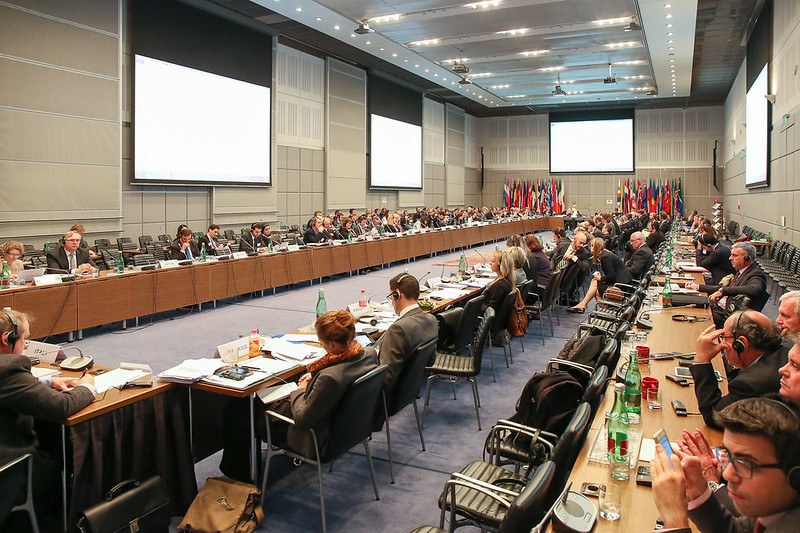Trump Backs Off From New Tariffs Amidst Heightened Trade Tensions
On Aug. 12, the Trump administration announced a delay in plans to impose new tariffs on Chinese imports. President Trump had previously said that starting on Sept. 1, the United States would issue a “small additional tariff of 10 percent on the remaining 300 Billion Dollars of goods and products coming from China into our country.” Combined with the 25 percent tariffs that the U.S.
Published by The Lawfare Institute
in Cooperation With

On Aug. 12, the Trump administration announced a delay in plans to impose new tariffs on Chinese imports. President Trump had previously said that starting on Sept. 1, the United States would issue a “small additional tariff of 10 percent on the remaining 300 Billion Dollars of goods and products coming from China into our country.” Combined with the 25 percent tariffs that the U.S. has already placed on $250 billion worth of Chinese goods, an additional tariff on $300 billion in goods would have meant tariffs on practically all Chinese exports. Under the new scheme, however, tariffs on $111 billion worth of Chinese goods will still take effect on Sept. 1, with the remainder of the tariffs set to take effect on Dec. 15.
Commerce Secretary Wilbur Ross has maintained that the administration’s delay in certain tariffs was meant to protect American consumers from suffering price increases during the Christmas season and did not represent a concession to Beijing. Still, the administration’s delay has sent U.S. stocks surging and for the moment prevented trade tensions from spiraling further out of control.
However, Trump’s initial announcement of new tariffs had already provoked a quick and severe response from the Chinese government. Beijing immediately announced that Chinese companies would suspend purchases of U.S. farm produce. The National Development and Reform Commission and the Ministry of Commerce also announced that China will not rule out the possibility of levying additional tariffs on imported U.S. farm produce. CNBC reports that China’s suspension of agricultural purchases will further burden U.S. farmers, who have in the past year alone “struggled through record flooding and an extreme heat wave.” According to data from the U.S. Department of Agriculture (USDA), agricultural exports to China dropped from their 2017 value of $19.5 billion to $9.2 billion in 2018. To compensate farmers, USDA has to date dispensed $8.6 billion in “direct aid payments to farmers,” though critics have argued that the administration’s bailouts have benefited large corporate farms “while leaving small farmers in the lurch.”
In addition, China has allowed the yuan to drop to its lowest value since 2008—China has kept its currency below a seven-to-one ratio to the dollar for the past 11 years but on Aug. 5 allowed the renminbi to trade at 7.05 per dollar, crossing a symbolically significant threshold. On the same day, the U.S. Treasury Department designated China a currency manipulator under Section 3004 of the 1988 Omnibus Trade and Competitiveness Act. In a press release, Treasury argued that “Chinese authorities have acknowledged that they have ample control over the RMB exchange rate” and that the “purpose of China’s currency devaluation is to gain an unfair competitive advantage in international trade.” A weaker currency makes a country’s exports cheaper, though experts have pointed out that China is unlikely to allow significant depreciation of the yuan, as this could lead to capital flight and constrain growth.
Just days after the Treasury Department’s announcement, the International Monetary Fund (IMF) made public a report that described the renminbi as “broadly stable.” As Doug Palmer of Politico has argued, the IMF report provides “little or no support for ... Trump’s assertion that China is manipulating its currency for an unfair trade advantage.” Chinese media was quick to seize on the IMF report, with China Daily arguing that the IMF report makes clear that the U.S. Treasury’s accusation of currency manipulation is “nothing but troublemaking.” Moreover, Mark Sobel, a former Treasury official, has publicly argued that it is “foolhardy to argue China is ‘manipulating’ its currency.” Sobel noted that China has over the past year propped up the renminbi “against downward pressures” and that the Trump administration now paradoxically wants China “to ‘manipulate’ its currency up, rather than let it fall in response to market forces set off by the president’s own tariff pronouncements.”
Amid heightened trade tensions, the U.S. government’s announcement of a tariff delay “is being regarded in Beijing as a step toward detente.” Chinese and American negotiators are still set to meet in Washington in September for a new round of talks. Though the prospects for a trade agreement remain uncertain at best, Trump’s tariff reversal has prevented—if only momentarily—a further slide in bilateral relations.
Draft Measures Flesh Out Implementation of Cybersecurity Law
Over the past few months, the Cyberspace Administration of China (CAC) has released draft measures to implement the 2017 Cybersecurity Law. These measures help clarify many of the law’s most important provisions. Most prominently, several of the draft measures have focused on regulations surrounding the transfer of data across borders. The Draft Measures for Security Assessment of Export of Personal Information, which were released in June, would “increase the compliance burden for both domestic and overseas companies that collect personal information from China.” The 2017 draft guidelines provided two methods for the Chinese government to analyze security concerns related to the export of data: a self-assessment conducted by the companies and then submitted to the government and an assessment conducted by the government itself. The government assessment would apply only to operators handling certain types of personal data. Under the new 2019 draft measures, however, companies will instead be allowed to export data only if they receive approval from the relevant CAC provincial office. Such assessments will take place either twice a year or if the companies change the type, reason for or length of data export. Additionally, the measures do not state whether transfers may continue while an approval is pending, which could prove disruptive for companies in the midst of seeking approval.
As part of their application to the CAC, data exporters must submit not only a risk analysis but also an “Export Contract” between the network operator and the party that will receive the exported data. Companies must also submit annual reports to the CAC regarding data breaches, maintain records for the CAC’s inspection, and allow the CAC to cut off the transfer of personal information in the event of a failure or inability to protect personal information.
In addition to the regulations for the transfer of personal information, the CAC released draft measures on “important data” in May 2017, which includes information connected to “national security, economic development or public interest”—a still broad and ill-defined category. Companies that handle such data are deemed “critical information infrastructure operators” (CIIOs) and the broad array of companies that could fall under this designation remains a source of concern for many firms. Such CIIOs must encrypt important data and preserve copies. They must also comply with mandatory assessment and authorizations by provincial CAC offices—just as for firms that store personal information—and, in addition, must designate a specialized data protection officer. Finally, the assessment process will also apply to companies that attempt to share or release “important data” within China, not just across borders, which broadens the law’s scope.
Overall, the implementing measures enshrine a fairly rigorous system for companies seeking to share important data or personal information abroad by requiring government assessment and approval prior to the transfer. This may encourage companies to store data entirely within China. Furthermore, review of the applications will also be a considerable source of new work for the CAC, which may need to hire additional employees to handle the process. The draft measures will continue to draw attention as firms look for guidance on how to adhere to the Cybersecurity Law.
In Other News
- On Aug. 12, PEN America published a “statement in response to report the FBI is urging universities to monitor Chinese students and scholars.” The statement noted that despite the suspicion that the Chinese government is “engaged in espionage of American higher education,” the U.S. government must “tread carefully” as it seeks to minimize that threat of espionage. The statement concluded that “efforts by the United States to fend off the global arm of autocracy must not mimic the very tactics it professes to reject.” Twenty-two organizations, including the American Association of University Professors and the National Coalition Against Censorship, signed onto the statement. As Emily Feng of NPR has reported, FBI officials have already visited “at least 10 members of the Association of American Universities,” advising universities to “monitor [Chinese] students and scholars.”
- The People’s Bank of China (PBOC) has indicated that it will soon launch its own state-backed cryptocurrency. Mu Changchun, deputy director of the PBOC’s payments department, said that both the PBOC and other financial institutions would be able to issue the currency. The new cryptocurrency has the potential to “reduce the costs of circulating traditional paper currency” and to “speed up and add security to digital transactions.” As one commentator has noted, China “has so far had a rocky relationship with bitcoin and crypto, with Beijing ... shutting down bitcoin exchanges.” PBOC’s announcement, however, could herald a new era in the cryptocurrency revolution.
- E-commerce platform JD.com has reported better-than-expected second quarter revenue, reporting a 23 percent jump in revenue from the same period last year. As Business Insider notes, that revenue jump represented a “surprise profit amid analyst expectations for a net income loss.” Indeed, JD’s revenues “grew at their slowest pace on record” in the first quarter of this year. As China’s e-commerce industry slows down, behemoths like JD and Alibaba have sought to diversify their services. A recent SCMP piece reported that JD is “exploiting artificial intelligence ... to help drive online consumption in smaller cities and among female users.”
Commentary
In the New York Times, Baobao Zhang makes the case for why the United States will need to expand its social safety net as artificial intelligence (AI) becomes more widespread and considers how China may approach the challenge as well. A new report by Anthony Cordesman examines China’s national security strategy and recent military developments. For the Jamestown Foundation’s China Brief series, Elsa Kania and Peter Wood identify the key themes in the Chinese government’s 2019 National Defense White Paper. In Foreign Affairs, Richard McGregor analyzes the forces motivating Chinese President Xi Jinping to govern more assertively than his predecessors.
In the Washington Post, Eswar Prasad considers the different tools available to the Chinese and U.S. governments as the trade war continues. As the trade war transitions into a potential currency war as well, Jeffrey Frankel reviews the repercussions of that shift in the Globe and Mail. For the Center for New American Security, Ashley Feng and Neil Bhatiya discuss the effect of the trade war on U.S. sanctions policy.
On Lawfare, Paul Rosenzweig considers why measuring the value of cybersecurity is so difficult. On the Cyberlaw Podcast, Stewart Baker, Paul Scharre and Greg Allen discuss military applications of AI, including concerns raised about the risks associated with Google’s AI research in China (43:56).




-(1).png?sfvrsn=fc10bb5f_5)

